► Audi’s next electrified decade planned
► Confirmed: 30 electrified model lines by 2025
► The platforms, the PHEVs, the future models
VW Group has laid out its plans for its electric and plug-in hybrid cars over the next decade, and Audi is going to play a huge role in that transformation. While cars like the Volkswagen ID.3 target the mass market and SEAT pursues micromobility, Audi’s job is to attract customers in the premium sector.
How will Audi manage it? We’ve already seen the Audi e-Tron SUV, the e-Tron Sportback, the Q4 e-Tron and the e-Tron GT, but what else is on the horizon? Keep scrolling for a full round-up of Audi’s electric future.
Audi’s electrification plan
Pre-Christmas announcements include Audi’s bold plan to go for all-electric production from 2029. The brand’s intentions will see it launch only all-electric models from 2026, phasing out production of its fossil-fuelled models and PHEV variants between now and 2033.
Former Audi CEO Bram Schot told CAR at the 2019 Frankfurt motor show that the brand needs to answer customers’ demands by offering a more focused range of models. In an interview with CAR, he stated that he would like 25% fewer model lines and variations as quickly as possible, which represents quite a shift in Audi’s philosophy.
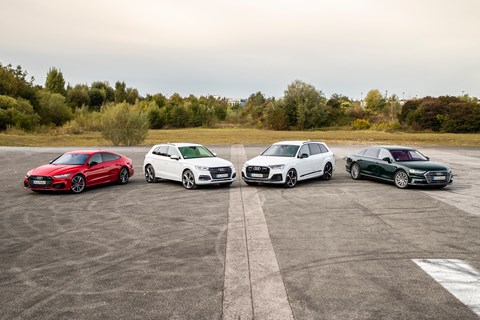
The dedication to protect Mother Earth isn’t just about cars for the consumer, either. The ‘360factory’, as it’s being termed, is shorthand for explaining that all existing production facilities will be retooled to deliver on these all-electric ambitions. The brand is keen to only build new plants where additional capacity is needed and has already committed to serious environmental goals, such as ‘protection and preservation of biodiversity’ and being ‘wastewater-free’.
What that translates to for the average road user is that a massive chunk of VW Group money is being thrown at Audi to cull the hybridisation of existing models and forthcoming models will be made sustainably. The first all-electric model to roll off the production line in Inglostat – the pilot site for this fancy new plan – is the forthcoming Audi Q6 e-tron, being made on the same line as the Audi A4 and A5. Inglostat is to serve as a blueprint for all the future factory transitions around the globe.
Audi has confirmed that it will be using four platforms to explode its range of electric cars in the decade to come, namely: MEB, MLBevo, J1 and PPE. Please bear with us while we explain these…
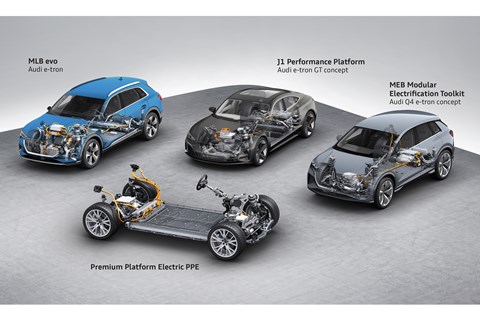
- MEB you might recognise, as it’s the abbreviation that’s been thrown around for the past few years within the VW Group. The platform is designed to underpin small to medium battery-electric cars, with the first production model being the Volkswagen ID.3. SEAT’s first shot is the near-identical El Born, while Skoda has launched the Enyaq on the same platform. Audi, meanwhile, sees the architecture as useful for its smaller, lower-end cars in the years to come.
- MLBevo is already in service with the e-Tron SUV and subsequent derivatives. It’s an updated version of the MLB platform that VW Group has used for some time, though this one has been engineered to house an all-electric powertrain.
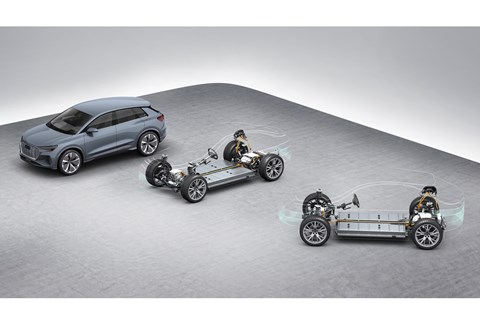
- The J1 platform was predominantly developed by Porsche, with Stuttgart using it mainly for the Taycan EV. Audi has nicknamed it the ‘performance platform’ due to its lower centre of gravity and punchy battery outputs. Due to its super-sports potential, Markus Jeschke, Audi’s project manager for the smaller MEB platform, said that J1 ‘cannot have an SUV variant.’ Hence why Porsche’s Taycan spin-off – the Taycan Cross Turismo – is an off-road estate rather than a full SUV.
- We know the least about the fourth architecture, called Premium Platform Electric. This has been designed and developed with Porsche, too, and is a scalable platform designed for underpinning the higher-end and larger-sized range of vehicles to come from Audi over the next decade. In fact, the PPE architecture has both ‘low floor’ and ‘high floor’ options, meaning it’ll be useful for everything from the next A6 to the next Q7. Audi is already dreaming up saloons, Avant estates and SUVs to run on this platform in future.
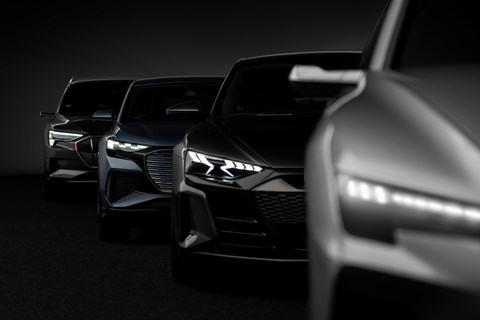
In fact, Audi revealed in an exclusive behind-the-scenes preview a design study of a forthcoming model designed to sit on the PPE platform. To us it looks like an A7 Sportback with the face of one of the brand’s AI concepts, but that’s arguably a tad reductive. Keep scrolling for more on this elusive new model.
What Audi electric cars are there, and what can we expect?
Audi e-Tron SUV and e-Tron Sportback
The electric Audi e-Tron SUV has been on sale since 2018, but it was only the beginning of the brand’s electrification plans. In 2019 it was joined by the e-Tron Sportback, a coupe SUV variant with a sleeker roofline.
Prices for the e-Tron start north of £60,000, with an electric motor on each axle offering up to 402bhp in Sport mode. A colossal 95kWh battery pack forms a big chunk of the car’s 2.5-tonne kerbweight, but it’s necessary to achieve the 248 miles of range to keep pace with its rivals. A smaller 71kWh battery was later added as an option, offering 198 miles of range.
The e-Tron Sportback followed in 2019, and it too has the same powertrain and battery options, returning 241 and 185 miles of range respectively. You’ll pay a little more for the privilege of a more stylish body, but that roof also impacts on practicality to a degree.
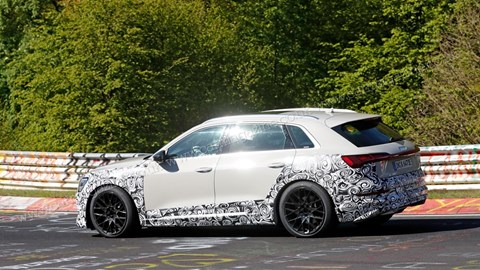
There are sportier versions of each variant, called the e-Tron S and the e-Tron S Sportback. These get an additional motor for 496bhp, and in SUV form you can expect 0-62mph in 4.5sec. Which is quite sprightly for a posh family car.
Read more about the Audi e-Tron here
Read more about the Audi e-Tron Sportback here
Audi e-Tron GT
How do you move on from a big electric SUV? With a sporty grand tourer, that’s how. The Audi e-Tron GT continues the new, electric design language introduced on the e-Tron SUV, and transposes it onto an A7-style body – though at 4.96m long, 1.96m wide and 1.38m high, it’s both lower and slightly wider than that conventional grand tourer. And although it uses the aforementioned J1 platform developed by Porsche, this is unmistakably an Audi.
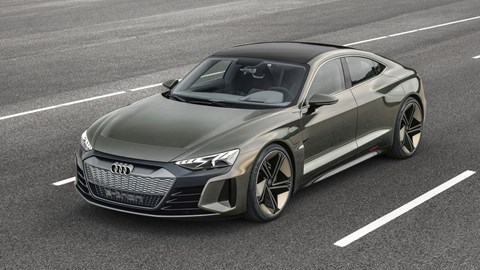
Launched in 2021, it comes in two flavours: the e-Tron GT quattro and the sportier RS e-Tron GT. The former develops 469bhp (rising to 523bhp in boost mode), resulting in a 0-62mph figure of 4.2sec and a top speed of 152mph. Meanwhile the latter generates up to 637bhp with the boost setting engaged, dropping the 0-62mph time even lower to 3.3 seconds. The extra punch costs some range however, with the RS dropping from 280 miles down from the standard car’s 295.
While it sits on the same platform as the Porsche Taycan, the e-Tron GT chooses a different path with a softer, more forgiving ride. This makes it more suited to longer journeys rather than b-road shenanigans, although if you do find yourself on a sweeping country road in the e-Tron GT it certainly won’t disappoint.
Read our Audi e-Tron GT review here
Audi Q4 e-Tron
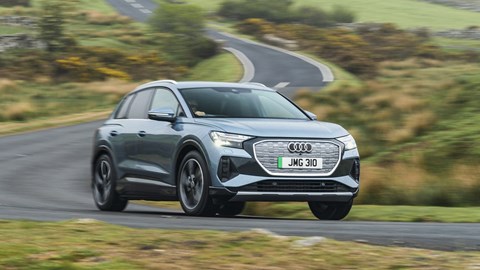
The Audi Q4 e-Tron is the brand’s second electric SUV, following the launch of the e-Tron back in 2018. Confused about the nomenclature here? Don’t worry, you’re not the only one.
While the original e-Tron SUV was built upon a platform initially designed for a combustion engine, the Q4 e-Tron is a more bespoke affair. It uses the same MEB underpinnings as the Volkswagen ID.4 and Skoda Enyaq, and Audi’s interpretation of this VW Group product might just be the best of the lot.
The Q4 e-Tron was introduced in the summer of 2021, with prices starting at £40,750 for the entry-level 35 version. Equipped with a 52kWh battery it delivers 216 miles of range, and the rear-wheel drive powertrain delivers 168bhp and 229lb ft of torque for 0-62mph in nine seconds flat.
The Q4 e-Tron 40 ups the ante to 201bhp, and the 0-62mph time drops by half a second despite the addition of a beefier, 77kWh battery that unlocks up to 328 miles of range. This costs £44,990; significantly cheaper than the top-spec 50 Quattro model, which sees its range fall to 309 miles on account of its extra power.
As is the case with the larger e-Tron, there’s also a Sportback version of the Q4 e-Tron too. It follows the same recipe of additional style, as long as you’re prepared to compromise rear headroom.
Read our Audi Q4 e-Tron review here
Read our Audi Q4 Sportback e-Tron review here
Audi PB e-Tron
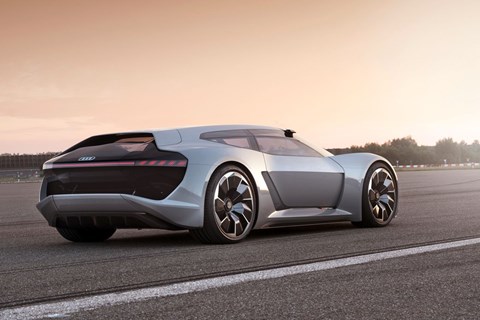
At the 2018 Monterey Car Week, we saw a range of new concept cars from Mercedes to Infiniti, but it was the Audi PB18 e-Tron that caught our attention. It was the first project designed by Audi’s new Malibu-based North American design team, and looks like a futuristic take on the Audi R8 from the front, but throws away the rulebook completely at the rear.
After a year of being nicknamed the PB18, though, Audi decided to change its name to the AI:Race concept at the 2019 Frankfurt motor show to bring it more into line with the likes of the rest of its super-futuristic concepts under the same tag; namely the AI:Me, AI:Con and Blade Runner moon buggy-like AI:Trail.
From a shooting-brake rear, to a mid-battery-mounted layout, the new PB18 features some key design details which we could see in forthcoming electric production cars like the next R8…
Audi R8
That being said, no set-in-stone decision has been made on how the Audi R8 and, indeed, the TT are going to be replaced. Speaking about the new cars at Frankfurt a couple of years ago, CEO Schot said ‘this is a decision made from the heart. These are halo models and are extremely important to us. They might not be called TT and R8 or they might be called that, either way it is still to be decided. But we do still need to offer a super sports car.’
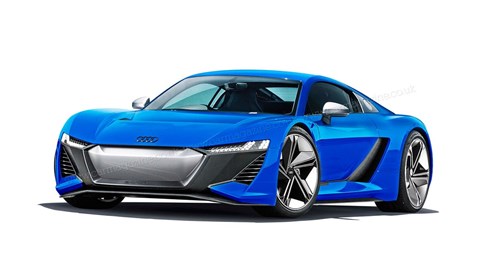
‘There will be a fully electric version, but we still have to decide if there will be other version two. There is probably going to be a move towards longer range plug-ins for instance. We need to make the decision quickly, certainly within the year, perhaps by Christmas,’ he added.
Our sources suggested that Audi approached Rimac for help to launch the RS e-Tron all-electric supercar – the zero-emissions rocketship rumoured to replace the Audi R8, which is on death row as the world turns its back on profligate fossil fuel dinosaurs. It’s the natural fall-out as the VW Group ruthlessly pivots its product range around the new electromobility holy grail. But that doesn’t mean no more exciting Audis – far from it.
Indeed, if – and that really is quite a large if Audi – were to make the next R8 fully electric, it would make sense to use the performance car-oriented J1 platform. A product rep from Audi was quick to quash that suggestion, though, claiming that Audi’s focus for the customer was specifically to make a four-door GT car first: the e-Tron GT. That doesn’t mean it’s not still possible.
Audi GrandSphere concept
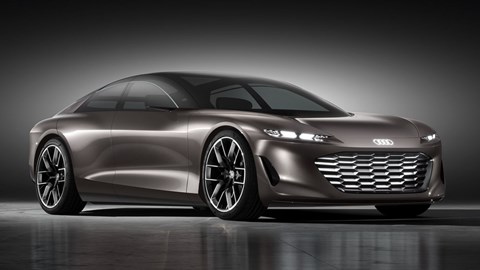
In the second half of 2021 Audi revealed its latest concept car, an autonomous electric machine that’s expected to replace the A8 saloon in 2025. The GrandSphere is so sophisticated that it was described as ‘a private jet for the road’.
It’s not hard to see why. Audi is working on uber-secretive, next-generation electric tech that it hopes will revolutionize the market in a few years time. The GrandSphere concept uses a 120kWh battery pack for 466 miles of range, and a motor on each axle is meant to develop a total of 710bhp, 679lb ft of torque and a 0-62mph to rival your average supercar. The word you’re looking for is ‘strewth’.
But there’s more. Audi is targeting Level 4 autonomy (one level shy of entirely driverless technology), and the customary dashboard has been replaced with a full-width screen that can house anything from video conference calls to feature length movies.
Then there’s the design. Just look at it. It’s 5250mm long with a wheelbase of 3190mm, as well as being a full two metres wide. Audi design boss Marc Lichte has told CAR that he has ‘never been as proud’ of his work as he is with the GrandSphere. High praise indeed.
Read more about the Audi GrandSphere concept here
Further electric car reading
The best electric cars and EVs on sale today
How much does it cost to charge an electric car?
The best hybrids, plug-ins and PHEVs